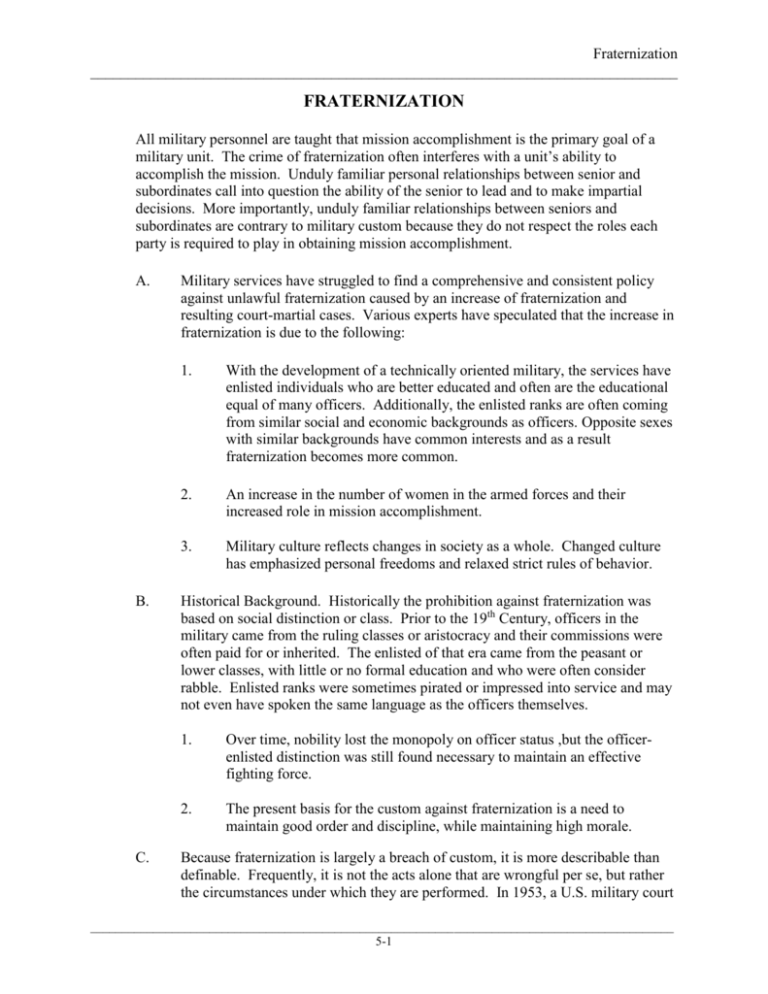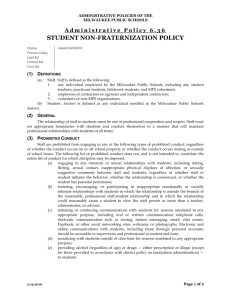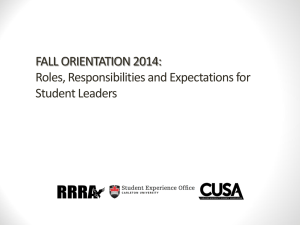
Fraternization
______________________________________________________________________________
FRATERNIZATION
All military personnel are taught that mission accomplishment is the primary goal of a
military unit. The crime of fraternization often interferes with a unit’s ability to
accomplish the mission. Unduly familiar personal relationships between senior and
subordinates call into question the ability of the senior to lead and to make impartial
decisions. More importantly, unduly familiar relationships between seniors and
subordinates are contrary to military custom because they do not respect the roles each
party is required to play in obtaining mission accomplishment.
A.
B.
C.
Military services have struggled to find a comprehensive and consistent policy
against unlawful fraternization caused by an increase of fraternization and
resulting court-martial cases. Various experts have speculated that the increase in
fraternization is due to the following:
1.
With the development of a technically oriented military, the services have
enlisted individuals who are better educated and often are the educational
equal of many officers. Additionally, the enlisted ranks are often coming
from similar social and economic backgrounds as officers. Opposite sexes
with similar backgrounds have common interests and as a result
fraternization becomes more common.
2.
An increase in the number of women in the armed forces and their
increased role in mission accomplishment.
3.
Military culture reflects changes in society as a whole. Changed culture
has emphasized personal freedoms and relaxed strict rules of behavior.
Historical Background. Historically the prohibition against fraternization was
based on social distinction or class. Prior to the 19th Century, officers in the
military came from the ruling classes or aristocracy and their commissions were
often paid for or inherited. The enlisted of that era came from the peasant or
lower classes, with little or no formal education and who were often consider
rabble. Enlisted ranks were sometimes pirated or impressed into service and may
not even have spoken the same language as the officers themselves.
1.
Over time, nobility lost the monopoly on officer status ,but the officerenlisted distinction was still found necessary to maintain an effective
fighting force.
2.
The present basis for the custom against fraternization is a need to
maintain good order and discipline, while maintaining high morale.
Because fraternization is largely a breach of custom, it is more describable than
definable. Frequently, it is not the acts alone that are wrongful per se, but rather
the circumstances under which they are performed. In 1953, a U.S. military court
_____________________________________________________________________________________________
5-1
Defense Institute of International Legal Studies
_____________________________________________________________________________
articulated in its decision what is now recognized as the classical definition of
fraternization:
D.
E.
1.
“Because of the many situations which might arise, it would be a practical
impossibility to lay down a measuring rod of particularities to determine
in advance what acts are prejudicial to good order and discipline and what
are not. As we have said, the surrounding circumstances have more to do
with making the act prejudicial than the act itself in many cases. Suffice it
to say, then, that each case must be determined on its own merits. Where
it can be shown that acts and circumstances are such as to lead a
reasonably prudent person, experienced in the problems of military
leadership to conclude that good order and discipline…has been
prejudiced by the compromising of an enlisted person’s respect for the
integrity…of an officer, there has been the offense [of unlawful
fraternization].”
2.
A more simplistic, but accurate definition of unlawful fraternization
includes the following: Fraternization is any over- familiarity that
erodes the senior-subordinate relationship. Fraternization involves an
improper superior-subordinate relationship which detracts from the
authority of the superior and thereby adversely effects good order and
discipline.
Actual or apparent preferential treatment or improper use of rank prejudices good
order, discipline, and high unit morale. Fraternization will affect a unit by:
1.
Compromising the chain of command by an erosion of respect for the
senior leaders; and
2.
By creating the appearance of favoritism, which in turn destroys morale.
If someone perceives that another is receiving better treatment because of
something occurring outside of job performance, then a problem exists. It
is not a defense to say, “…we’re just friends...”; and
3.
Hindering the ability of a leader to perform by undermining his or her
command authority and calling into question a senior’s objectivity; and
4.
By creating situations in combat that could result in lives being placed at
risk.
Traditionally, the focus of unlawful fraternization was the relationship between an
officer and an enlisted service member or the senior-subordinate relationship.
______________________________________________________________________________________
2
Fraternization
______________________________________________________________________________
1.
It is possible to have unlawful fraternization between officers and officers
or enlisted and enlisted. To have this type of misconduct, you need to
have an unduly familiar relationship which is actually prejudicial to good
order and discipline. To prove this type of relationship, a command will
employ a “two-step test.” Contrast this with the more traditional form of
fraternization between an officer and an enlisted service member. In the
“traditional” form, the “one-step test” is used. If the relationship is found
to be unduly familiar, by definition fraternization exists and the
relationship is presumed to be prejudicial to good order and discipline.
2.
Fraternization is also gender neutral. It does not have to involve intimate
relationships between members of the opposite sex.
3.
Traditionally, the senior partner in a fraternizing relationship was the one
held accountable. However, under current U.S. service policies, though
the senior member has primary responsibility for deterring fraternization,
both parties are now accountable for their actions.
4.
Commands have also defined unlawful fraternization in regards to their
own special needs. These policies are usually grounded in common sense
and established case law as the commanding officer strives for mission
accomplishment. Special relationships which may be a basis for unlawful
fraternization include:
a.
Non-commissioned officers (NCOs) occupy a unique leadership
and are separate and distinct leaders within a command. They
provide leadership, not just in their chain of command, but for the
entire unit. Therefore, if a relationship between a noncommissioned officer and someone in the pay-grade of 0-6 and
below is unduly familiar, fraternization is presumed to exist as
long as they are attached to the same command. If the individuals
are not attached to the same command, the “two-step test”,
mentioned above, should be utilized.
b.
Staff/Instructor-Student Relationships. Unduly familiar
relationships which do not respect the staff-student relationship are
presumed to be prejudicial to good order and discipline and are
often prohibited.
c.
Recruiters-Recruits/Applicants. Unduly familiar relationships
which do not respect the recruiter-recruit dynamics are presumed
to be prejudicial to good order and discipline and are often
prohibited.
d.
Service Members who are Married. Service members who are
married or otherwise related to each other must maintain the
_____________________________________________________________________________________________
5-3
Defense Institute of International Legal Studies
_____________________________________________________________________________
requisite respect and decorum while either is on duty or in uniform
in public. However, a marriage stemming from a previously
existing improper relationship does not excuse those involved from
responsibility for their activities prior to the marriage.
II.
FRATERNIZATION – U.S. MILITARY POLICY
A.
Fraternization is an issue with armed forces-wide implications. Given the
different customs, traditions and mission statements of the various services
however, some variance on how fraternization is interpreted is inevitable. In
recent years, in order to find a common ground among themselves, all U.S.
military services have reviewed and revised their various policies on
fraternization. This can be a difficult area of the law to interpret because of the
necessity to develop camaraderie and respect among the ranks while maintaining
high morale. At the same time, good order and discipline must be maintained
and are essential for an effective fighting force. A balancing test of these
competing interests requires a common sense approach and positive leadership to
avoid problems within the unit.
B.
All services prohibit personal and business relationships between higher and
lower ranking service members. Examples of prohibited personal relationships
include:
1.
Dating.
2.
Cohabitation – except in situations of operational necessity.
3.
Intimate/sexual relationships.
4.
Gambling.
5.
Relationships between recruiters and recruits, as well as relationships
between drill instructors and initial trainees.
6
Examples of prohibited business relationships.
a.
Loaning/borrowing money.
b.
Business Partnerships: Service members of different ranks cannot
go into business together.
c.
Commercial Solicitation: If a higher ranking service member runs,
is affiliated with, or knows of a private company, he/she cannot
solicit business for that company from a lower ranking service
member.
______________________________________________________________________________________
4
Fraternization
______________________________________________________________________________
C.
D.
III.
Fraternization policies are not intended to stop normal unit/team building
functions or normal social interaction between people like:
1.
Community functions – service members of all ranks live on military
installations. When the installation holds activities for all service
members, for example Fourth of July activities, this is not fraternization.
2.
Religious activities – service members of all different ranks worship
together at their churches/synagogues/mosques.
3.
Unit based social functions – many units have, for example, picnics/family
days which involve service members of all ranks.
4.
“Right arm” nights – A tradition, especially in the Army, where an officer
will take a trusted and valuable enlisted service member, mostly
noncommissioned officers (NCO), to the officer club for drinks and dinner
to show appreciation to that service member.
5.
Athletic events – many units put together teams to compete in local sports
leagues. Service members of all ranks may participate.
Fraternization policies are not intended to stop routine, limited business
transactions like:
1.
Landlord/Tenant relationships – service members of higher rank who may
own property and rent it out to service members of lower rank are not
guilty of fraternization.
2.
One-time transactions like the sale of a vehicle or home.
POSSIBLE CONSEQUENCES OF COMMITTING
FRATERNIZATION IN THE U.S. MILITARY
A.
Fraternization is a violation of the Uniform Code of Military Justice (UCMJ).
The various service regulations prohibiting fraternization are considered punitive
orders. Also, the Commanders of most installations and units have issued their
own punitive orders strictly forbidding fraternization.
B.
If a service member is engaging in fraternization a full range of disciplinary
options is available to the Commander:
1.
Counseling and/or an oral/written reprimand.
2.
Order to cease improper relationship.
3.
Reassignment and/or adverse evaluation report.
_____________________________________________________________________________________________
5-5
Defense Institute of International Legal Studies
_____________________________________________________________________________
C.
4.
Nonjudicial punishment – a commander may conduct a hearing into the
matter and if he/she finds that the service member has been engaging in
fraternization he/she may restrict the service member to a certain area,
impose extra duty, take some of the service member’s pay, or demote the
service member to a lower rank. Article 15, UCMJ
5.
Administrative separation. A service member may be sent to an
administrative discharge board. This board will review whether the
service member should remain on active duty and, if not, what type of
discharge to award.
6.
Impose a bar to reenlistment – in those cases involving enlisted personnel,
a service member can be prohibited from reenlisting when his/her current
obligation expires.
7.
“Flagging” – puts a halt to all favorable personnel actions for a
servicemember (i.e. promotion, awards, and schooling).
8.
Courts-martial – the maximum penalty for fraternization is a Dishonorable
Discharge (“Dismissal” in the case of an officer), reduction to the lowest
enlisted grade in the case of enlisted servicemembers, forfeiture of all pay
and allowances, and imprisonment for up to 2 years.
The unique aspects of fraternization and its inherent limitations on personal
freedoms have at times called into question its constitutional viability. In fact, all
manner of constitutional challenges have been leveled against the concept of
fraternization. Despite these challenges, the United States Supreme Court, as well
as lower courts, has largely recognized the military’s unique need for discipline,
against which certain personal liberties may be sacrificed. Unsuccessful
challenges to criminal proceedings relating to fraternization include:
1.
Freedom of Association. This right is afforded less weight because of the
negative impact fraternization has on discipline. The prohibition is “valid
and necessary” to preserve good order and discipline while at the same
time discouraging inappropriate conduct between seniors and
subordinates.
2.
Vagueness. The existence of a long acknowledged custom, and the
circumstances surrounding the misconduct, make the prohibition against
fraternization specific.
3.
Equal Protection. Officers have always been held to a higher standard of
conduct, so it is reasonable to single them out. Some regulations
governing fraternization apply to the instructor-student relationship, even
______________________________________________________________________________________
6
Fraternization
______________________________________________________________________________
when the instructors are also enlisted. Singling out this group of enlisted
personnel has also been held to be reasonable because of their temporary
special status as teachers.
4.
IV.
Privacy. There is no right to privacy when it compromises discipline.
The need for discipline has been called a compelling state interest when
weighed against an individual service member’s need for sexual privacy.
FRATERNIZATION IN CIVILIAN SOCIETY/PUBLIC SECTOR
A.
While lives are not at stake and the superior/subordinate dividing line is not as
strict in the public sector as in the military, fraternization can still be a problem
because it can reduce the efficiency and productivity of an organization.
B.
When speaking of fraternization in the public sector, we are mainly dealing with
intimate/romantic relationships between employees.
C.
Fraternization in the workplace, both in the military and civilian sector, can raise
problems like:
D.
1.
Sexual harassment claims.
2.
Charges of favoritism - co-workers can resent the special treatment they
perceive the subordinate is receiving from his/her superior.
3.
Discipline problems – the ability to administer effective discipline can be
eroded if a superior engages in fraternization with a subordinate.
4.
Discord and disruptions – two employees romantically involved may bring
disagreements and relationship problems to work.
5.
Scheduling and leave problems – can arise when two employees
romantically involved want to take time off together.
6.
Information access – if an employee has access to confidential information
that can directly benefit his/her romantic partner, the employee may find it
difficult to keep this information confidential to the other.
Civilian fraternization policies: while not as strict as the military policies, some
public sector organizations have adopted fraternization policies. These include:
1.
Definition of fraternization and scope of policy – the agency should
clearly state what kinds of relationships are covered and what activities are
either prohibited or restricted.
_____________________________________________________________________________________________
5-7
Defense Institute of International Legal Studies
_____________________________________________________________________________
V.
2.
Protection against disparate impact – the agency should make sure that
neither men nor women are being affected disproportionately by
application of the policy. Subjective measures should not be used to
decide whether the policy has been violated or not.
3.
Efficiency/productivity reasons – the agency formulating a fraternization
policy should document the legitimate efficiency/productivity reasons for
the policy, e.g. conflicts of interest, potential charges of sexual
harassment.
4.
Uniform and fair application of policy – the policy must be applied
uniformly to both management and non-management employees. The
agency should avoid making exceptions to the fraternization policy and
should apply it without regard to gender.
CONCLUSION
Unfortunately, fraternization is very much a viable issue in today’s armed forces.
Somewhat unique among crimes in that the acts alone are not wrongful per se, but rather
become an offense because of the circumstances under which they are performed. First
and foremost, fraternization presents a significant leadership challenge for the
commanding officer. A commanding officer is tasked with developing camaraderie and
respect among the ranks while maintaining good order and discipline. A balancing test
of these competing interests requires both a common sense approach and positive
leadership to avoid problems caused by unlawful fraternization.
______________________________________________________________________________________
8








